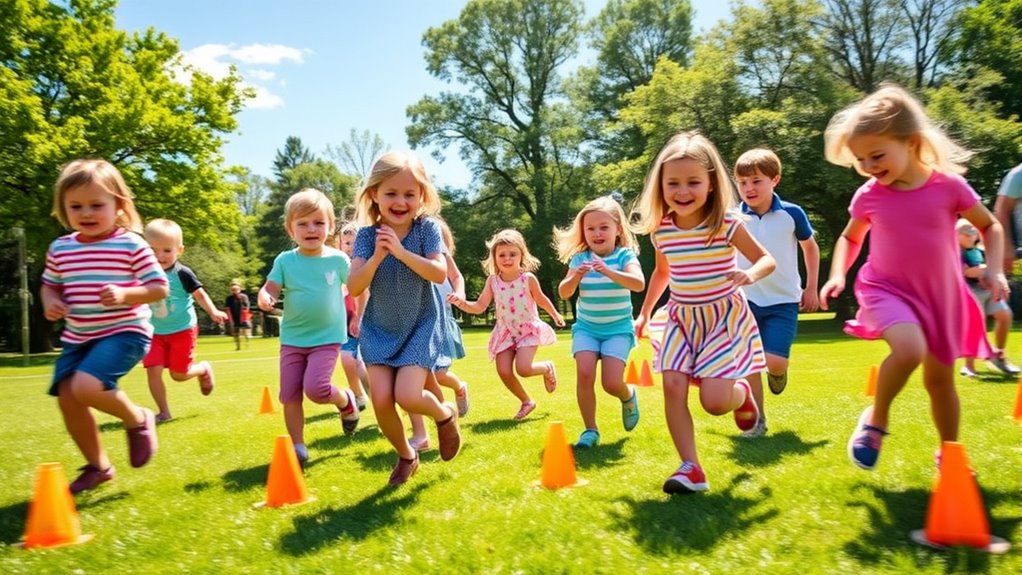Follow the leader games are excellent for teaching kids to listen carefully and follow instructions, which are key social skills. As the leader, you set fun actions for children to imitate, encouraging participation and group interaction. You can adapt these activities to different environments and themes, making them engaging and age-appropriate. Rotating roles and adding challenges keep children interested while building patience and confidence. Keep exploring ways to make these games even more effective and enjoyable.
Key Takeaways
- Follow the Leader games teach children essential skills like listening, following directions, and group cooperation through engaging activities.
- The leader’s role involves setting actions for others to imitate, with activities tailored to age and skill levels.
- Rotating leaders and roles promotes inclusion, social interaction, and enhances understanding of group dynamics.
- Activities can be customized for different settings and themes, such as classroom tasks, playground fun, or themed challenges.
- Reinforcement strategies like positive feedback and varied roles keep games motivating, helping children develop confidence and attentive listening skills.

Have you ever played a game where everyone follows one person’s lead, trying to mimic their actions or stay in step? These “Follow the Leader” games are more than just fun—they’re powerful tools for teaching kids essential skills like listening and following directions. When you run these activities, you tap into group dynamics, which influence how children interact, cooperate, and respond to cues. Understanding and managing group dynamics helps you create a cohesive, engaging experience where every child feels involved and motivated. Plus, activity customization allows you to tailor the game to suit different age groups, skill levels, and settings, making the activity more effective and enjoyable.
Follow the leader games teach kids valuable skills while promoting group interaction and adaptable fun.
In these games, the leader’s role is vital but flexible. You can choose a child or take the lead yourself, guaranteeing the activities stay engaging and appropriately challenging. As the leader, you set actions for the group to follow, which could be simple movements like jumping or more complex sequences involving spins or balancing. The key is to keep the activity dynamic enough to hold everyone’s attention but straightforward enough for children to follow easily. By adjusting the complexity of actions, you customize the activity to match the participants’ abilities, fostering confidence and encouraging participation.
Group dynamics come into play as children observe, imitate, and respond to your lead. When kids follow one another, they learn about cooperation, patience, and attentiveness. You’ll notice some children may be more eager to lead, while others might be shy or hesitant. Managing these differences is part of activity customization—perhaps by rotating leaders or providing different roles within the game. This approach helps create a balanced environment where everyone gets a turn and feels valued. As children become more familiar with the game, their ability to listen carefully and follow instructions improves, boosting their self-control and social skills.
You can also modify the game to fit various settings, whether in a classroom, a playground, or at a family gathering. For example, in a classroom setting, you might incorporate educational themes into the actions, such as mimicking animals or performing classroom-related tasks. On the playground, you could make it more energetic with running or jumping challenges. Customization ensures the activity stays relevant and fun, maintaining children’s engagement and maximizing learning outcomes. Whether you’re aiming to develop motor skills, enhance listening, or promote social interaction, these adaptable games allow you to create a tailored experience that benefits every child involved.
Ultimately, Follow the Leader games are versatile and effective. They teach listening, following directions, and social skills while accommodating different group dynamics through thoughtful activity customization. By adjusting the level of difficulty, roles, and themes, you keep the game fresh and challenging, encouraging children to participate actively and grow confident in their abilities. These activities aren’t just games—they’re valuable opportunities to build essential skills in a playful, engaging way. Incorporating positive reinforcement can further motivate children to stay attentive and engaged during the game, reinforcing their learning and confidence.
Frequently Asked Questions
How Can These Games Be Adapted for Different Age Groups?
You can adapt these games for different age groups by making age-appropriate adjustments and skill level modifications. For younger children, simplify instructions and use more visuals, while older kids can handle complex commands and faster pace. Incorporate themes relevant to their interests to boost engagement. By tailoring the game’s difficulty and content, you guarantee everyone stays challenged yet successful, fostering listening skills and following directions across all age ranges.
What Are Some Common Challenges Children Face During These Activities?
You might notice children struggle with attention span and comprehension skills during these activities. They often get distracted or have difficulty understanding complex instructions. To help, you can keep activities simple, break tasks into smaller steps, and give clear, concise directions. Encouraging active participation and offering positive feedback also boost their focus and understanding, making the game more enjoyable and educational for everyone involved.
How Do These Games Support Language Development?
Imagine a bridge connecting worlds—these games serve as that bridge for your child’s language growth. They boost auditory skills by encouraging kids to listen carefully and follow cues. As children engage, they strengthen social interaction, learning to share attention and respond appropriately. Through active participation, your child builds vocabulary and comprehension, making language learning a lively, interactive experience that fuels confidence and communication skills.
Can These Games Be Played Indoors and Outdoors?
You can definitely play these games both indoors and outdoors. For indoor adaptations, use smaller spaces and modify movements to fit inside, like walking in place or simple gestures. For outdoor variations, take advantage of larger areas for more active movements like running or jumping. These flexible options keep the game engaging no matter where you play, helping kids develop listening and following directions in different environments.
What Are Some Tips for Encouraging Shy or Hesitant Children?
Imagine a shy child hesitating to join a game. To encourage hesitant participation, you can gently include them by giving simple, supportive prompts. For example, praise small efforts to boost their confidence. You might say, “You’re doing great!” This helps shy children gain confidence and feel more comfortable. Remember, patience and encouragement are key to helping shy or hesitant kids build confidence and actively participate in games.
Conclusion
By playing follow the leader games, you not only boost listening and direction-following skills, but you also build confidence and teamwork. Did you know that children who regularly engage in such activities show a 30% improvement in their ability to follow complex instructions? So, next time you lead a game, remember you’re helping kids develop essential skills while having fun. It’s a simple yet powerful way to shape their growth and confidence every day.










